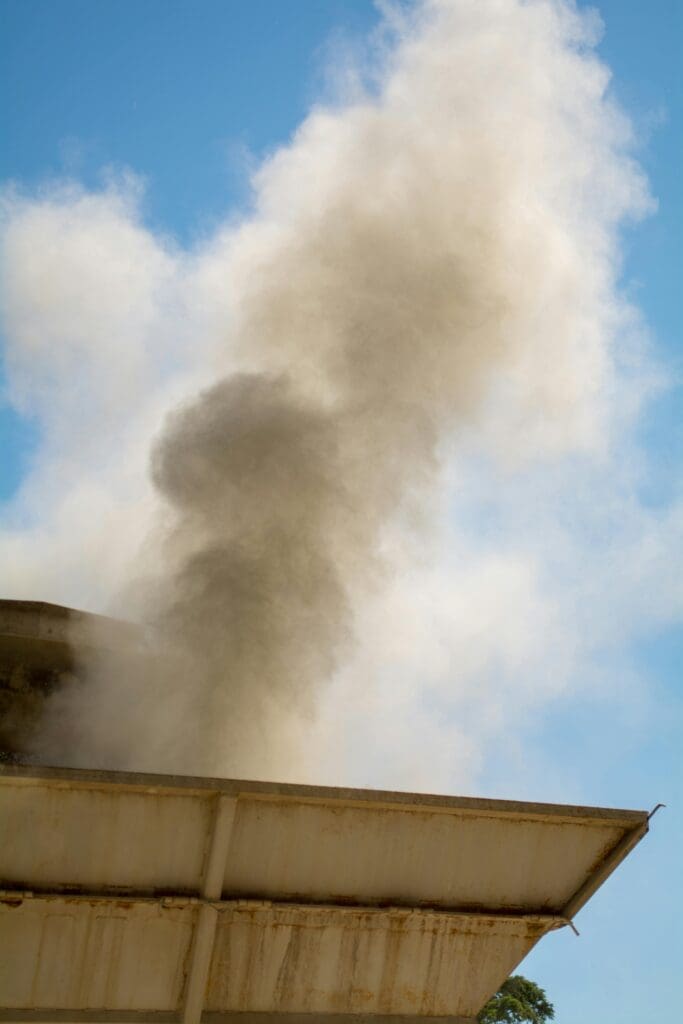Our environmental clients often ask us, “how do changes in air quality regulations affect my project?” We spoke to Environmental Project Engineer Brendan Farnham to learn how facilities can lower emissions and why meeting air quality standards is crucial for community health and project success.
What are air quality standards?
Air quality standards generally define the maximum allowable level of pollutants in the air to protect public health and the environment. An example are National Ambient Air Quality Standards (NAAQS), which establish limits on pollutant concentrations including carbon monoxide, lead, nitrogen dioxide, ozone, particulate matter, and sulfur dioxide.

Depending on the type of facility and the amount of pollutants released, air permits may be required for the construction and operation of the facility. Common air permits include New Source Review (NSR) permits, Title V permits, and Federally Enforceable State Operating (FESOP) permits. Air monitoring and modeling may be required during these permitting processes. Air modeling and/or air monitoring are also becoming more common for local zoning approvals, and construction and demolition projects.
These facilities may have to show they do not contribute to an exceedance of the NAAQS through monitoring, modeling and/or recordkeeping. For existing facilities, failure to meet the NAAQS or the standards identified in the facility’s air permit can result in violations and fines. Failure to meet the NAAQS for proposed facilities can result in permit or local zoning denials.
In 2024, the EPA lowered the NAAQS for particulate matter 2.5 microns or smaller in diameter (PM2.5) from 12 micrograms per cubic meter (ug/m3) to 9 ug/m3. The background concentrations of PM2.5 in many metro and industrial areas across the U.S. currently exceed 9 ug/m3, meaning that these areas will be non-attainment areas. Non-attainment areas have more stringent standards and requirements for pollutant emissions.

“The NAAQS changing from 12 ug/m3 to 9 ug/m3 is significant. Especially in metro areas where the background concentration exceeds the NAAQS. The new standard can be difficult to meet. But there are solutions to lower emissions—we can help.”
Brendan Farnham, Project Engineer
Managing air quality for existing or proposed facilities
Existing or proposed facilities may have to make changes to meet the NAAQS or other applicable emission standards. This can be accomplished in a variety of ways. The first is by reducing air emissions. These efforts could include:
- Installing added or more advanced air pollution control technologies
- Replacing existing combustion with green energy sources, cleaner fuels, or innovative fuel combustion techniques
- Adjusting systems to improve dispersion of pollutants before they reach the public
In some cases, this may not be enough to meet the emission standards. New or expanding major sources in nonattainment areas would need to obtain emission offset credits from existing sources located in the vicinity that (1) offset the emissions increase from the new source or modification and (2) provide a net air quality benefit.
Complying with air quality regulations
Partnering with environmental consultants who understand the complexities of air quality regulation is the best way to stay compliant, avoid violations and obtain or maintain your “license to operate”.
At V3, our team will assess all available options. Through applied and subject-matter expertise, we help clients identify the right technology and methodology to improve emissions and keep projects moving forward.
We provide the following services:
- Air quality screening and dispersion modeling
- Air monitoring
- Permit applications
- Air quality impact assessments
- Control technology evaluation
“I enjoy putting together air dispersion models. They can get pretty complex, but this work helps identify concerns, target solutions for reducing emissions and improve the air quality for surrounding populations.”
Our Environmental experts offer support every step, providing the detailed reporting and agency relationships to get projects approved. Connect with our team to learn more.

